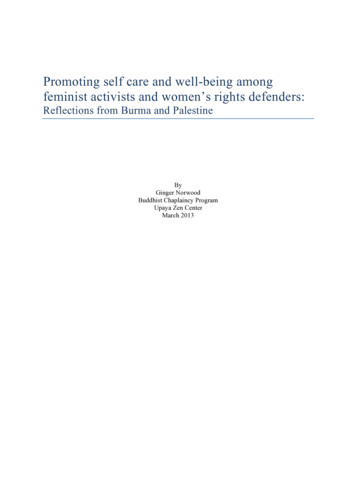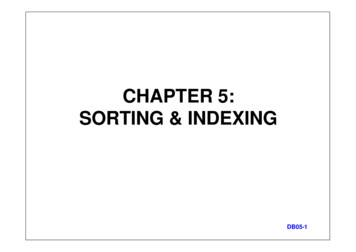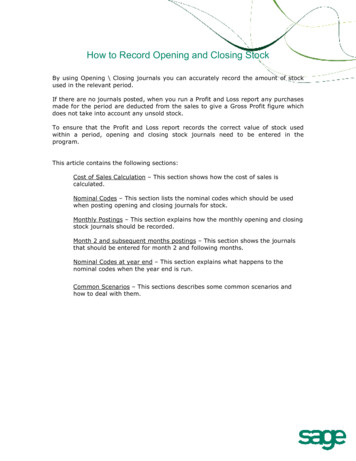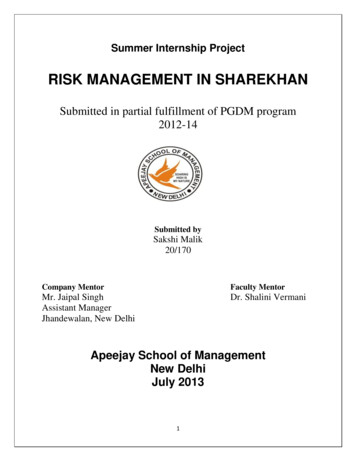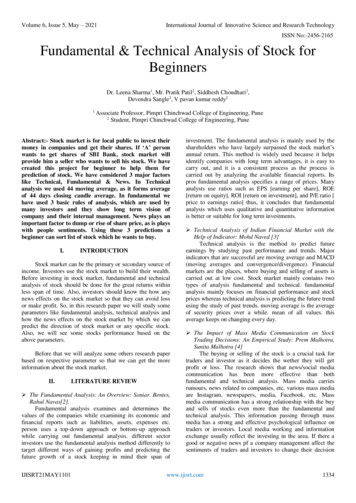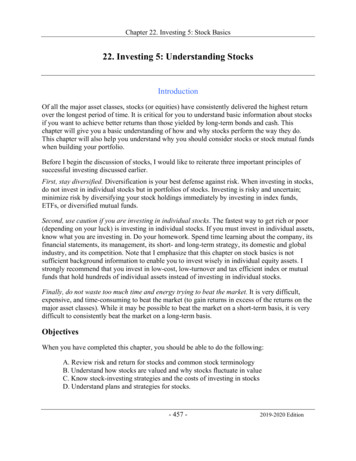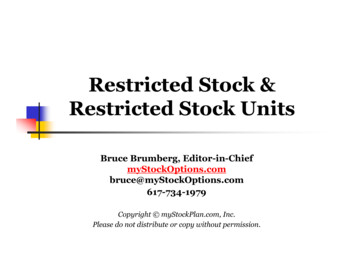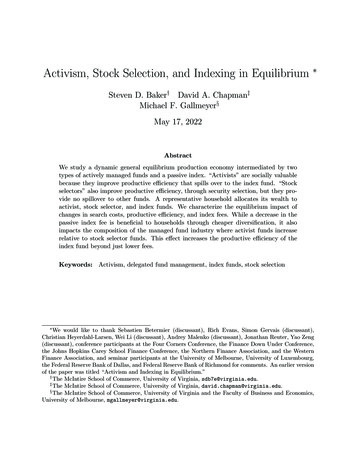
Transcription
Activism, Stock Selection, and Indexing in Equilibrium Steven D. Baker† David A. Chapman‡Michael F. Gallmeyer§May 17, 2022AbstractWe study a dynamic general equilibrium production economy intermediated by twotypes of actively managed funds and a passive index. “Activists” are socially valuablebecause they improve productive efficiency that spills over to the index fund. “Stockselectors” also improve productive efficiency, through security selection, but they provide no spillover to other funds. A representative household allocates its wealth toactivist, stock selector, and index funds. We characterize the equilibrium impact ofchanges in search costs, productive efficiency, and index fees. While a decrease in thepassive index fee is beneficial to households through cheaper diversification, it alsoimpacts the composition of the managed fund industry where activist funds increaserelative to stock selector funds. This effect increases the productive efficiency of theindex fund beyond just lower fees.Keywords: Activism, delegated fund management, index funds, stock selection We would like to thank Sebastien Betermier (discussant), Rich Evans, Simon Gervais (discussant),Christian Heyerdahl-Larsen, Wei Li (discussant), Andrey Malenko (discussant), Jonathan Reuter, Yao Zeng(discussant), conference participants at the Four Corners Conference, the Finance Down Under Conference,the Johns Hopkins Carey School Finance Conference, the Northern Finance Association, and the WesternFinance Association, and seminar participants at the University of Melbourne, University of Luxembourg,the Federal Reserve Bank of Dallas, and Federal Reserve Bank of Richmond for comments. An earlier versionof the paper was titled “Activism and Indexing in Equilibrium.”†The McIntire School of Commerce, University of Virginia, sdb7e@virginia.edu.‡The McIntire School of Commerce, University of Virginia, david.chapman@virginia.edu.§The McIntire School of Commerce, University of Virginia and the Faculty of Business and Economics,University of Melbourne, mgallmeyer@virginia.edu.
1IntroductionIf a firm’s managers are destroying shareholder value, an asset manager faces two primarychoices: voice or exit. Voice, or activism, is generally understood to describe a broad range ofshareholder actions designed to influence a firm’s real or financial policy decisions. As such,it is recognized as one important component of corporate governance. We build a generalequilibrium model of the asset management industry with activism at its heart. Our goalis to understand how activism coexists with alternative asset management channels such asactive stock selectors and passive index funds. We want to understand the implications offee compression for household welfare and for the relative sizes of the different fund channels,where fee compression is defined in the financial press as the reduction in active managementfees coincident with increased passive management.The foundation of the model is a set of productive technologies representing industries.A representative household can invest in these technologies through three different typesof intermediaries: a passive index, activists, and stock selectors. The passive fund allowsthe representative household access to an equal-weighted portfolio of all industries at low orzero fees. Its existence captures the intuition that the household does not require a skilledmanager to spread capital evenly across the equity market, but the household does requirea skilled manager to identify the most efficient investments.An activist creates a fund by incurring a search cost to match with an industry, exercisingvoice, and forcing the industry to use its capital efficiently. The industry remains efficient aslong as it is matched with an activist. This is the direct benefit of voice. However, the activistalso generates a positive externality because the increase in industry efficiency contributes toincreased performance for the passive index. A stock selector, at times referred to as just aselector, invests in an industry via an active strategy that resembles security selection withinan industry. This security selection allows the stock selector fund to generate high cash flows1
from an industry without generating a spillover to the other investors in that industry. Bothactivists and stock selectors choose fees optimally in a symmetric Nash equilibrium, giventhe state of competition in the managed fund market.The household determines the demand for each of the three types of funds by solving anoptimal consumption and portfolio choice problem. In equilibrium, the markets for goodsand fund shares clear, determining the aggregate size of each fund sector. We examine thekey factors determining the interactions among agents through a set of numerical experiments. We focus on how fee structures and changes in the active investors’ technologiesaffect the relative sizes of the fund management sectors, and how the composition of theactive management sector affects household welfare.For a wide range of parameter values, a non-degenerate stationary distribution for eachfund type exists in the model’s steady state. Our baseline parameterization demonstrateshow fund market competition impacts assets under management and household welfarethrough both diversification and spillover effects. Although the equilibrium characteristicsof activists and stock selectors are similar in many ways, their responses to changes in thestate variables are not necessarily identical. For example, due to the nature of their investingprocess, stock selectors can displace incumbent activists by investing in the same industries.This introduces a “predator/prey” component to the dynamics of the relative sizes of theactivist and stock selector sectors that can lead to interesting interaction effects.But the absence of spillovers from stock selectors can also create space for activists, bymaking activism more profitable. For example, as the number of activist funds grows, thehousehold invests more in the activist sector overall as this sector becomes better diversified.However, more activist funds also make the passive index more efficient, leading to a spillovereffect that eventually makes assets under management in the active sector fall. Stock selectorsdo not generate a spillover effect. If more of them are in the market, activist assets undermanagement can actually rise as activist funds are better complements to stock selector2
funds than the passive fund in the household’s portfolio.This dynamic between activists and stock selectors also has a differential impact on thepresent value of fees collected. As activists funds increase in number, the present value ofboth activist fees and stock selector fees fall due to increased competition. However, as thenumber of stock selectors increase, the present value of both activist fees and stock selectorfees rise. This non-intuitive result is driven by stock selector funds not generating a spilloverso the passive index is not a cheaper investment product to achieve the same cash flows.Declining passive index fees and fee compression have become commonplace in the assetmanagement industry.1 Understanding their impact on investor welfare requires a dynamicassessment of their effect on the incentives for activists to participate in the asset managementindustry. Interestingly, our model can endogenously generate a pattern of falling fund feesand active management fund dynamics, as recently seen in the fund management industrywithout any changes in the model’s structural parameters. A decrease in the passive indexfee, a structural parameter in our model, provides the benefit of cheaper diversificationoptions, but it can be harmful to overall efficiency if the reduction in fees seriously curtails thenumber of activists willing to participate in the fund management industry. We demonstratethis process in a simple example that curtails stock selector entry. Without restricting stockselector entry, a decrease in passive index fees is welfare improving to households for bothlower fees and a reconfiguration of the composition of the managed money sector as activistsfare better in low fee environments than do stock selectors.We also explore how changes in the fund management technology impact fund competitiveness through search and monitoring and/or stock selection success. When activists facelower search costs for new investments, households are better off. Lower search costs forstock selectors, however, lead to higher fees and more money managed in selector funds to1See for example Morningstar’s Annual Fund Fee Study available at study.3
the detriment of households. Similar results hold when varying monitoring costs for activistsor stock selection success for selectors.The conventional focus of mutual fund and hedge fund research has been on whetheror not active management delivers “alpha” through the selection of mis-priced securities.Our purpose in emphasizing the role of voice is not to argue that he conventional focusis unimportant, but rather to argue that activism — and the interaction of activism andselection — may play a more important role in understanding asset management in generalequilibrium than has generally been acknowledged. This view is consistent with the recentsurvey evidence in McCahery, Sautner, and Starks (2016) and the empirical literature onactivism summarized in Brav, Jiang, and Kim (2015a).The rest of the paper is organized as follows: After placing our work in the context ofthe relevant literature on both shareholder monitoring and active management, we presentthe model and characterize the equilibrium. We then examine how the equilibrium respondsto changes in the cost of intermediation along several dimensions. The final section of thepaper concludes. All proofs are in the appendix.2Our Contribution Relative to the Existing LiteratureIn order for any shareholder (or group of shareholders) to effectively monitor firm managers,they must solve a free-rider problem; i.e., the costly efforts of shareholders who monitor thefirm also benefit other shareholders who exert no effort. This problem might be overcomeby large shareholders via takeovers, as in Shleifer and Vishny (1986). Yet ownership that istoo highly concentrated could lead to sub-optimally tight control by shareholders (Burkart,Gromb, and Panunzi, 1997), or to weaker monitoring incentives stemming from reduced liquidity and price informativeness (Holmström and Tirole, 1993). Assuming that the rightnumber of shareholders are paying the right amount of attention, providing improved in-4
centives to the firm’s managers remains a nontrivial problem (Core, Guay, and Larcker,2003).The results in Admati, Pfleiderer, and Zechner (1994) provide theoretical argumentsagainst the use of voice by demonstrating that the equilibrium level of monitoring is wellbelow its socially optimal level, and DeMarzo and Urosevic (2006) extend this result to showthat, over time, an activist will actually hold a perfectly diversified portfolio. Marinovicand Varas (2019) show that whether or not the activist monitors and whether or not thatmonitoring increases firm value depends critically on the presence of information asymmetryabout the activist’s ability.2Despite these substantial incentive and information obstacles, McCahery, Sautner, andStarks (2016) present survey evidence that over half of institutional investors engage directlywith the management and boards of the firms in which they hold stock, presumably to thebenefit of shareholders at large. The survey article of Brav, Jiang, and Kim (2015a) providesadditional empirical evidence of the impact of activism on firms. Brav, Jiang, and Kim(2015b) show, empirically, that activism has a positive impact on plant-level productivity.We sidestep the discordance of the theoretical results with the empirical findings byabstracting from the specific details of how activists change firm policies – and by extensionfirm value. Instead, we assume a matching technology that pairs fund managers (bothactivists and stock selectors) with firms. Once the match is formed, the monitoring requiresno costly effort by managers, and the representative household has perfect information aboutwhich firms are matched to each type of manager. We use voice and monitoring as a metaphorfor how active managers can deliver value to households in equilibrium in the absence ofasymmetric information. We are interested in understanding the factors that affect the2This additional layer of delegation also introduces new agency problems that have been the focus of alarge literature on optimal managerial contracting; see, for example, the theoretical work of Bhattacharyaand Pfleiderer (1985), Stoughton (1993), Heinkel and Stoughton (1994), Starks (1987), and the empiricalwork in Almazan et al. (2004).5
relative sizes of the active and passive sectors of the asset management industry and how thestructure of the asset management industry affects household welfare in general equilibrium.Pastor and Stambaugh (2012) provide an alternative explanation for the relative sizesof the active and passive sectors of the fund industry. Their focus is on explaining thepoor performance of active funds relative to a passive benchmark (the “active managementpuzzle”) in an equilibrium model where funds face decreasing returns to scale; i.e., whenfund performance erodes because too many managers trade in related strategies. Theirexplanation of active vs. passive sector sizes is complementary to ours. Their model is moregeneral than ours in that investors can learn about managerial skill while our frameworkassumes complete information. Our model is more general than theirs in that we incorporatea production economy and our household explicitly solves a multiperiod (infinite-horizon)portfolio problem.Whereas we focus on voice as a source of positive spillovers from active management,Buss and Sundaresan (2020) focus on improved price informativeness as a source of positivespillovers from active management. In theoretical and empirical examples, they documenta surprising positive relationship between high passive ownership and price informativeness.Their argument is that high passive ownership increases the incentive for information production by active managers. In our setting, passive and active fund shares are dynamic andendogenously determined, so the relationship is nuanced. When passive ownership is highbecause index funds charge low fees, activists and selectors compete by reducing fees too,which can benefit households overall despite reduced monitoring of firms by activists.Complementary to our work, Gervais and Strobl (2021) also study a model of fundmanagement where active fund managers impact production processes through the allocationof funds across firms. Their work, in a noisy rational expectations setting, studies a differentquestion from ours. They explore how performance benchmarking for active managers isconfounded by their real impact on the economy. They then demonstrate that it is still6
optimal to invest with these active managers even when their performance lags the marketportfolio. Both their work and ours show that welfare can be improved by the presence ofactive fund managers who impact a firm’s production process.In contrast to our work that studies the equilibrium dynamics of the size of the activelymanaged and passively managed sectors, Gârleanu and Pedersen (2018, 2019) and Corum,Malenko, and Malenko (2022) study the impact on market efficiency of endogenous costlyinformation acquisition in a noisy rational expectations equilibrium with one period of trade.Gârleanu and Pedersen (2018) explore how market efficiency is impacted when investorsincur search costs to find asset managers. Gârleanu and Pedersen (2019) extend this workby focusing on the impact on passive investing when there is a fixed number of active assetmanagers. Corum, Malenko, and Malenko (2022) build on both of these works by addinga governance choice to both active and passive managers in a setting where investors arerisk neutral. They show that increased passive investing can have an ambiguous impact onthe level of governance. Given we assume long-lived risk averse households as well as entryand exit of fund managers, we are able to explore fund management sector dynamics andhousehold welfare that are driven by spillover and diversification effects.We assume that passive managers provide diversification services at low cost, and theydo not engage in any use of voice or (by definition) other active strategies. Azar, Schmalz,and Tecu (2018) argue that even passive managers can facilitate collusion in concentratedindustries, to the detriment of households. However, there is a growing literature thatcontradicts the findings in Azar, Schmalz, and Tecu (2018); see, for example Dennis, Gerardi,and Schenone (2022).7
3ModelWe study a continuous-time, infinite-horizon economy in which the fund management industry intermediates between households and productive investment opportunities. We buildthe model from the bottom up, beginning with the productive technologies, or industries.Investment managers who are either activists or stock selectors search for opportunities tomatch with industries, thereby forming funds. A lower cost passive index fund also existswhich invests equally in all industries. Finally, a representative household optimally allocates capital across funds. Having closed the model, we solve and analyze fund and capitalmarket dynamics in general equilibrium.3.1IndustriesCapital may be productively invested in N industries. All industries have an identicalproductivity of capital µ, such that an industry i with capital Ki,t produces output at grossrate µKi,t dt. Capital in industry i also depreciates at a rate Ki,t δi,t dt σdW t σdWi,t .(1)The Brownian motion W t captures a capital depreciation shock common to all industries,whereas the Brownian motion Wi,t captures industry-specific depreciation, which is independent of W t or Wi0 ,t , i0 6 i.At any given time, the deterministic depreciation rate δi,t takes one of two values. Whenan industry is in an activist fund, depreciation takes a smaller value δi,t δA , reflecting realefficiency gains from monitoring. An industry that is not part of an activist fund is assumedto be inefficiently run, with δi,t δ δA . This simple reduced-form specification capturesthe idea that activism produces a positive externality, or spillover, through monitoring. We8
model an active manager’s “voice” in reduced form, but we have in mind mechanisms forvoice as discussed in the survey evidence in McCahery, Sautner, and Starks (2016).3For the most part, we can treat industries as the most basic level of productive technologyin our model. However, in Appendix A we further subdivide each industry into a continuumof firms. This subdivision rationalizes the following assumptions about the interaction ofstock selectors and industries.First, if a selector fund invests in industry i, it achieves an effective depreciation rate δS δ, but without altering the depreciation rate achieved by other investors in that industry.Appendix A rationalizes this outcome as a result of reduced-form security selection thatproduces no spillovers for the industry.Second, if a stock selector invests in industry i, then it displaces any activist currentlyinvested in industry i. The only fund type that may simultaneously invest in that industryis the index, which achieves depreciation rate δ on industry i investment. Appendix Arationalizes activist exit following selector entry as the result of arbitrage opportunities thatarise between selector and activist funds within the same industry, which have the effect ofdriving the activist’s assets under management (AUM) to zero in that industry.3.2FundsA large, but finite, number of ex-ante identically skilled managers search for opportunitiesin the labor market for asset managers. Managers match with industries to form investmentfunds, which may be either selector funds or activist funds. A fund consists of one industryand one manager. An unemployed (potential) manager may search for opportunities as eitheran activist or a stock selector, or may choose not to search at all. The choice is sensitive3We also assume that activism is always successful. As noted earlier, reality dictates that activism willnot always be successful and can be curtailed by free rider problems (Grossman and Hart, 1980; Shleiferand Vishny, 1986) or liquidity issues (Coffee, 1991). Recent empirical work on activism includes Becht et al.(2017) and Boyson and Pichler (2018).9
to the current competitiveness of the fund market. At any moment, there are at incumbentactivist funds and st incumbent selector funds. Potential managers who choose not to searchcan be thought of as remaining in the general household pool, earning reservation utilitywith certainty equivalent value cKt , where Kt is the aggregate capital stock, or equivalentlyaggregate wealth.4If a potential manager chooses to search, that manager pays a flow cost ζA Kt dt whilesearching for activist opportunities or ζS Kt dt for stock selector opportunities. New matchesare formed at ratesâ1 ν(N at st )ν ,tŝt1 ν (η(N at st ) (1 η)at )ν ,(2)for activists and selectors, respectively, where ât is the number of potential managers searching for activist opportunities and ŝt the number of potential selectors searching. In ourexperiments, we assume that the elasticity parameter ν 1/2 and that there is no differencein ν between activists and stock selectors. This corresponds to a prior belief that matchingis equally difficult for both manager types. However, there is a difference between activistsand selectors in the composition of candidate industries for matching, as potential activistsmatch only with industries without incumbent funds, whereas potential selectors may alsomatch with industries having activist incumbents. This gives rise to a predator-prey dynamicbetween stock selectors and activists, with parameter η [0, 1] modulating the strength ofthat dynamic. When η 1, selectors cannot displace incumbent activists, whereas whenη 0 stock selectors are only able to match with industries having incumbent activists. Inour baseline parameters we choose η 1/2.The constant returns to scale matching tech-nology that we use is standard in the broader labor literature; see for example Petrongoloand Pissarides (2001), Rogerson, Shimer, and Wright (2005), and Petrosky-Nadeau, Zhang,4The number of potential managers is not generally important to the setup, but we assume that thereare a large number of potential managers relative to industries.10
and Kuehn (2018).Constant returns to scale implies that individual potential activist and stock selectormanagers find matches at the respective rates N at s tât ν ,η(N at st ) (1 η)atŝt ν.(3)The chance a searching manager succeeds depends on the tightness of the labor market,a ratio of available target industries to searching managers. For most of our analysis, therate at which new selector funds match with incumbent activists is also the rate at whichincumbent activist funds dissolve.5 Finally, selector funds dissolve at an exogenous rate θSindividually, or θS st in the aggregate.Potential managers take the present value of their earnings as given when making searchdecisions.An incumbent activist manager earns fee income with time t present valueΦA (at , st , Kt ). An incumbent stock selector manager has present value of expected earnings ΦS (at , st , Kt ). Fee income depends on funds under management, which is determinedendogenously as a part of the household’s equilibrium asset allocation.Potential managers will enter the labor market (search) until the net present value of anew fund is zero. For activists, ât is the number of searchers6 such that (ΦA (at 1, st , Kt ) cKt )N at s tât ν ζA Kt .(4)When a potential activist matches with a target industry, that activist exchanges fee revenuesfor his household consumption stream. The exchange must be favorable enough, and the5We allow for the possibility that some activists also exit for exogenous reasons, at rate θA individuallyor θA at in the aggregate. We set θA 0 in our baseline parameters.6We allow ât to take nonnegative real values, rather than restricting it to nonnegative integer values,hence Equation (4) holds with equality. ât , and ŝt in Equation (5), can be interpreted more generally assearch intensities. As a practical matter, continuously-valued search intensities facilitate convergence of thenumerical solution routine.11
intensity of matching high enough, to justify the search costs. The equivalent condition forstock selectors is (ΦS (at 1, st , Kt ) cKt )η(N at st ) (1 η)atŝt ν ζS Kt .(5)We verify that one solution to the activist and stock selector fee-setting problems hasthe property that the present value of fees is homogeneous of degree one in capital Kt , suchthat they can be written ΦA (at , st , Kt ) φA (at , st )Kt for activists, and ΦS (at , st , Kt ) φS (at , st )Kt for selectors. This allows us to solve for ât , the number of potential managersseeking to start activist funds, such that ât φA (at 1, st ) cζA ν1(N at st ) ,(6)whereas ŝt , the number of potential managers searching to be selectors, satisfies ŝt E [φS (a0 , st 1) (at , st )] cζS ν1(η(N at st ) (1 η)at ) ,(7)where the conditional expectation over fees incorporates the probabilities of the new stockselector matching either an activist or an exclusively index industry.Finally, a third type of investment fund exists alongside stock selectors and activists: apassive index fund, which invests equally in each of the N industries. This fund is unique,requires no manager, and charges a small, exogenous, and constant fee rate φ̄I proportionalto capital under management.7 In addition to capturing competition from low-cost indexfunds, the passive fund reflects the idea that households do not require skilled managers inorder to spread capital evenly across all industries, but they do require skilled managers toidentify the most efficient investments. In a simple way, this captures the idea that fund7In our baseline parameterization, φ̄I 0.12
managers are better informed than households.3.3HouseholdsA representative household allocates capital to investment funds in order to maximize expected lifetime utility. While the state of competition among funds matters to households,there is no reason for households to differentiate between funds of a given type. For example,each activist charges an identical fee proportional to capital, and each invests in a unique— but equivalent — efficient industry. Hence it is optimal, for purposes of diversification,for the household to invest the same amount in each activist fund. The relevant question ishow much the household should invest in activist funds collectively.Without loss of generality, let the first at industries be activist funds, the next st industriesbe stock selector funds, and the remaining N at st industries belong exclusively to thethe passive index.8 We define composite Brownian motionsWA,t atXj 1Wj,t ,WQ,t aXt stj at 1Wj,t ,WI,t NXWj,t ,(8)j at st 1representing risk specific to activists, selectors, and the passive fund, respectively.While we have in mind that the passive fund fee φ̄I is small, a fractionN atNof its holdingsis inefficient, with higher depreciation rate δ. Both activist and stock selector funds offerhigher efficiency in the sense that their investments have lower depreciation rates: δA foractivists and δS for selectors. However these funds also charge commensurately higher feesproportional to capital under management. Fee rates may vary depending on the amount ofcompetition in the fund market. The stock selector’s fee rate is φ̄S,t 0, and the activist’sfee rate is φ̄A,t 0. Households and potential managers take these fees as given. Later we8Recall that funds consist of non-overlapping industry-manager pairs but the passive index invests equallyin every industry.13
explain how incumbent managers strategically set fees to maximize revenues.Households allocate aggregate capital, Kt , across the three types of funds, and also choosethe consumption-capital ratio ct . Let πA,t be the activists’ fraction of capital, πS,t the stockselectors’ fraction of capital, and the residual 1 πA,t πS,t is invested in the passive index.The aggregate capital accumulation process isdKt (µ ct )dt σdW tKt πA,t · πS,t (φ̄I δI,t )dt (1 πA,t πS,t ) (φ̄A,t δA )dt σ dWA,tat σ dWQ,tstσN(9) (φ̄S,t δS )dt N at st dWI,t at dWA,t st dWQ,t , whereδI,t 1((N at )δ at δA )N(10)is the mean depreciation rate of industries in the index. Since δA δ, Equation (10) capturespositive spillovers from activism: the more activists funds at , the more industries are efficient,which also benefits index investors through smaller index depreciation δI,t . The number ofstock selector funds st has no direct effect on index depreciation as selectors produce nospillovers.Households have CRRA utility, and choose consumption and a capital allocation to maximize their lifetime expected utility, Zmax{ct ,πA,t ,πS,t } t 0E01 γ ρt (ct Kt )e0subject to Equation (9).141 γ dt ,(11)
4EquilibriumThe economic state is summarized by the tuple ωt (st , at ), a Markov process capturingcurrent competition in the fund market based on the number of stock selectors and activists,as well as the aggregate capital stock Kt . Since the economy is time-homogeneous, we omittime subscripts in the solution.4.1The Fund Managers’ ProblemsWe begin by solving for a manager’s entry dec
Christian Heyerdahl-Larsen, Wei Li (discussant), Andrey Malenko (discussant), Jonathan Reuter, Yao Zeng (discussant), conference participants at the Four Corners Conference, the Finance Down Under Conference, the Johns Hopkins Carey School Finance Conference, the Northern Finance Association, and the Western
